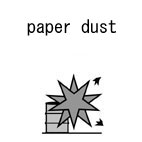| Case Name |
An explosion of paper powder on regular exchange work of a cutter in the paper-machine room at a paper manufacturing plant |
| Pictograph |

|
| Date |
February 5, 1995 |
| Place |
Akabira, Hokkaido, Japan |
| Location |
Paper mill |
| Overview |
Paper powder accumulated in the duct of the dust collector at the paper mill. Paper powder floated in the air in the paper machine room, and the humidity was low. The powder ignited during normal work, and the paper powder exploded. A dust explosion of suspended particulates indoors spread. Insufficient environmental management seems to be the cause. |
| Incident |
Paper powder ignited during operations to wind a roll of paper at a paper mill, and paper powder exploded. Suspended particles in the room also exploded. |
| Processing |
Manufacture |
| Individual Process |
Others |
| Substance |
Paper powder |
| Type of Accident |
Explosion |
| Sequence |
1. At a paper mill, a cylinder of a cutter that cuts off a base-sheet from a dryer of a paper machine in a paper machine room was operated with air pressure.
2. Next, the cutter that tears off the base-sheet from the dryer of the paper machine was to be operated. At this time, paper powder in a dust collector of the system ignited, and the paper powder exploded.
3. Combustion was propagated with suspended dust in the room, and the explosion spread to whole the paper machine room. |
| Cause |
The ignition source has not been specified. As paper powder had accumulated over a long time, it had dried and been carbonized, and could ignite. Or, the following is considered as anignition source: static electricity or contact sparks of a cutter and a paper machine. Accumulation of paper powder in the dust collector and a dust cloud in the paper machine room were the causes of the explosion. In addition, the humidity in the room was low at 15% or less. |
| Countermeasures |
1. The machinery should be improved to decrease dust accumulation and metal friction in dust collecting equipment.
2. Paper powder should be reduced by reexamining the capacity of the dust collector, methods of dust collection, cleaning of the dust collector, etc.
3. Environmental conditions in the room such as the humidity and temperature should be appropriately controlled.
4. Strengthening of safety management regulations, improvement of the operation standard, and enhancement of safety education were performed, while the safety management system was improved. |
| Knowledge Comment |
Paper is combustible, and a dust explosion of paper powder can occur. It is necessary to treat solid material that generates powder as carefully as the vapor phase of a dangerous liquid. |
| Background |
1. The capacity of the dust collector was insufficient, and dust accumulated in the duct of the dust collector.
2. Measurement of the work environment was not taken. It was not certain whether the concentration of floating dust in the room was appropriate, or whether the humidity in the room was controlled properly.
3. Basically, there seems to have been a lack of investigation on safety in handling combustible powder, and a lack of safety countermeasures. |
| Reason for Adding to DB |
Example of dust explosion of unexpected material |
| Scenario |
| Primary Scenario
|
Poor Value Perception, Poor Safety Awareness, Inadequate Risk Recognition, Organizational Problems, Poor Management, Poor Operation Management, Ignorance, Insufficient Knowledge, Insufficient Study/Experience, Planning and Design, Poor Planning, Poor Design, Usage, Operation/Use, Wrong Maintain of Environment, Secondary Damage, External Damage, Explosion, Bodily Harm, Injury
|
|
| Sources |
Japan Industrial Safety and Health Assoc. Safety and health information center. Cases of labor accident. No.1055
Paper powder exploded during work in a paper machine room when repairing a paper mill. The Japan Industrial Safety and Health Assoc. home page.
|
| Number of Injuries |
1 |
| Financial Cost |
¥ 522 million. (Fire and Disaster Management Agency) |
| Field |
Chemicals and Plants
|
| Author |
KOBAYASHI, Mitsuo (Office K)
TAMURA, Masamitsu (Center for Risk Management and Safety Sciences, Yokohama National University)
|
|